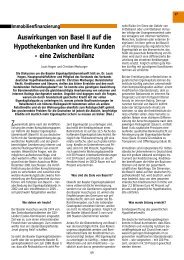The Pfandbrief 2011 | 2012
The Pfandbrief 2011 | 2012
The Pfandbrief 2011 | 2012
Create successful ePaper yourself
Turn your PDF publications into a flip-book with our unique Google optimized e-Paper software.
Regulation of rating agencies: Time for new priorities?<br />
protected website. Other agencies not engaged by them should then (as long as they meet<br />
certain requirements) be given access to this website. <strong>The</strong> purpose of this procedure was to<br />
prevent “rating shopping” for structured financial products – a practice that previously was<br />
not uncommon. This would have created a level playing field with the USA, where a very similar<br />
regulation was passed at the end of 2009.<br />
However, the final amendment to the Regulation governing rating agencies was passed<br />
without this reform. <strong>The</strong> amendment to the Regulation that entered into force on 1 June<br />
<strong>2011</strong> essentially retained only the transfer of regulatory authority from the national supervisory<br />
authorities in Europe to the newly created European Securities and Markets Authority<br />
(ESMA).<br />
Practical Experience and the Need for Reform<br />
76<br />
<strong>The</strong> Regulation has far-reaching administrative ramifications for the rating agencies, not least<br />
because of the comprehensive organisational requirements. Has anything changed for issuers,<br />
as well? <strong>The</strong> agencies have grown more conservative in their assumptions and at the<br />
same time, more pro-active in communicating. Fitch, Moody’s and S&P have tightened their<br />
assumptions and stress scenarios several times since the onset of the financial crisis. Toughening<br />
certain assumptions was an almost compulsory reaction to the experiences acquired<br />
from the crisis in the financial markets. Understandably, the agencies do not wish to be criticised<br />
once again for reacting too late.<br />
Premature Rating Measures and Announcements<br />
In many respects, however, the agencies’ actions have produced some strange phenomena.<br />
For example, they appear to want to publish announcements about upcoming changes in<br />
methods and/or models and the potential impact of these on <strong>Pfandbrief</strong>e particularly early.<br />
In 2009, S&P published a draft of its new covered bond rating methodology and announced<br />
that approximately 68% of all outstanding covered bonds could be negatively affected by the<br />
planned changes. This news caused a great deal of anxiety in the covered bond market. When<br />
the final version of the new method was published nearly a year later and several months after<br />
that the review of the outstanding covered bond ratings had been completed, it turned out that<br />
far fewer covered bonds were affected by the negative rating measures. <strong>The</strong> agency can be<br />
credited with some issuers having taken steps to optimise their collateral in order to maintain<br />
the desired (generally triple-A) rating.<br />
<strong>The</strong> rating agency Fitch stated in an October 2009 press release that it was placing nine<br />
Mortgage <strong>Pfandbrief</strong>e, with cover pools consisting mainly of commercial property loans,<br />
on the watch list. It justified this action by announcing that it wanted to test its commercial<br />
property financing risk assumptions. Only in May 2010 did Fitch publish a paper intended to
















